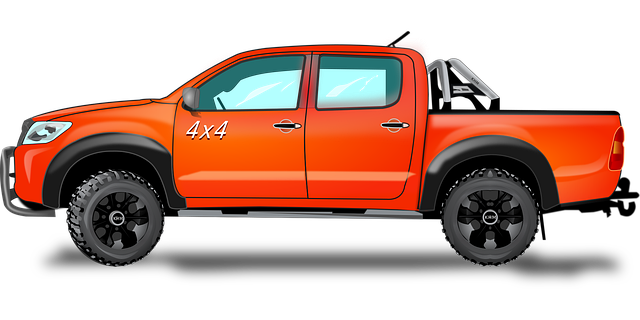Rotors, key components in RGV (Heavy Goods Vehicle) performance enhancements, are durable discs or cylinders made from steel or aluminum with blades for fluid/air movement. High-performance rotors offer superior heat dissipation and durability, enhancing braking efficiency and withstanding heavy-duty trucking demands. Rotor types impact RGV truck performance: solid rotors for heavy-duty apps and vented rotors for versatile braking across conditions. Advanced rotor technologies improve braking systems, heat dissipation, reduce wear, extend lifespans, and ensure consistent braking power in extreme temps, boosting safety and efficiency. Optimal RGV truck performance requires regular rotor maintenance, quality parts, lubrication, and pad/rotor balance to prevent accelerated wear and reduce costs. Future rotor designs will incorporate advanced composite materials, digital technologies for improved aerodynamics, smart sensors for predictive maintenance, driving RGV truck performance to new heights of efficiency, durability, and responsiveness.
Rotors are a vital component in the world of heavy-duty vehicles, particularly in RGVs (Rigid Grid Vehicles), playing a pivotal role in ensuring optimal truck performance. This article delves into the intricate details of rotors, exploring their basic components, diverse types, and how advanced technologies enhance RGVs’ capabilities. We discuss maintenance practices to maximize rotor lifespan and highlight future trends shaping the industry. Understanding rotors is essential for any RGV operator aiming to optimize vehicle efficiency and overall truck performance.
- Understanding Rotors: The Basic Components
- Types of Rotors and Their Applications in RGVs
- Enhancing Truck Performance: The Role of Advanced Rotor Technologies
- Maintenance and Care: Ensuring Optimal Rotor Lifespan
- Future Trends: Innovations Shaping Rotor Design in the RGV Industry
Understanding Rotors: The Basic Components

Rotors are fundamental components in various mechanical systems, including those found in RGV truck performance enhancements. They consist of a rotating disc or cylinder, often made from durable materials like steel or aluminum, which serves as the central part of a rotating assembly. Attached to this core are blades or vanes that facilitate the movement of fluids, air, or other substances. In the context of trucks, rotors play a crucial role in systems such as brakes and cooling fans.
Understanding rotor design and function is essential when considering RGV truck performance upgrades. High-performance rotors offer improved heat dissipation, leading to better braking efficiency and reduced overheating during intense driving conditions. They are engineered for enhanced durability and can withstand the demanding demands of heavy-duty trucking applications.
Types of Rotors and Their Applications in RGVs

Rotor types play a pivotal role in defining the performance capabilities of RGV (Recreational/Utility Vehicle) trucks. One common type is the solid rotor, known for its durability and heat dissipation properties, making it ideal for heavy-duty applications where high-temperature operations are frequent. This design choice significantly impacts the overall RGVtruckperformance, especially during extended use in challenging environments.
Another notable variant is the vented rotor, designed with cooling holes to facilitate air flow, enhancing braking performance under diverse conditions. These rotors are versatile and cater to a wide range of driving scenarios, ensuring optimal RGVtruckperformance regardless of terrain or load. Their ability to manage heat effectively contributes to longer component lifespan, which is crucial for maintaining the vehicle’s overall efficiency over time.
Enhancing Truck Performance: The Role of Advanced Rotor Technologies

In the pursuit of enhancing RGV truck performance, advanced rotor technologies play a pivotal role. These innovative solutions are designed to optimize braking systems, enabling better control and efficiency on the road. By incorporating cutting-edge materials and designs, rotors offer improved heat dissipation, leading to reduced wear and tear and extended component lifespan.
For instance, high-performance rotors engineered with specific alloys can withstand extreme temperatures, ensuring consistent braking power during intense driving conditions. This not only boosts safety margins but also enhances the overall RGV truck performance. Such technological advancements cater to the demands of modern transportation, pushing the boundaries of efficiency and reliability in the trucking industry.
Maintenance and Care: Ensuring Optimal Rotor Lifespan

Rotor maintenance and care are paramount for ensuring optimal lifespan and peak performance in RGV truck applications. Regular inspection is key; checking for signs of wear, corrosion, or damage. Replacement parts should meet stringent quality standards to maintain original equipment functionality. Proper lubrication is another critical aspect, as it reduces friction and prevents premature rotor degradation.
Additionally, maintaining the right balance between brake pad condition and rotor health is essential. Imbalanced or worn pads can accelerate rotor wear, leading to reduced braking efficiency and increased maintenance costs. Therefore, adhering to a rigorous maintenance schedule, utilizing high-quality components, and monitoring pad conditions will contribute to prolonging rotor life, enhancing safety, and optimizing RGV truck performance.
Future Trends: Innovations Shaping Rotor Design in the RGV Industry

The future of rotor design in the RGV (rotary gear vehicle) industry is brimming with innovation, driven by a relentless pursuit of enhanced performance and efficiency. One prominent trend is the integration of advanced materials, such as lightweight composites and high-strength alloys, to reduce weight and improve fuel economy without compromising structural integrity. These materials not only enable faster acceleration and better handling but also contribute to overall vehicle sustainability.
Additionally, digital technologies are playing a pivotal role in rotor design, with Computer-Aided Design (CAD) software allowing for precise engineering and rapid prototyping. This digital transformation facilitates the exploration of novel shapes and geometries, leading to improved aerodynamic performance and reduced drag. Moreover, the adoption of smart materials and sensors promises to revolutionize RGVs by providing real-time data on rotor health, enabling predictive maintenance and enhancing overall truck performance. These innovations collectively point towards a future where RGV trucks achieve unparalleled efficiency, durability, and responsiveness.
Rotors play a pivotal role in the performance and longevity of RGVs, as evidenced by their diverse applications and continuous technological advancements. From enhancing braking efficiency to improving overall truck performance, understanding and optimizing rotor design is key. As the RGV industry evolves, future trends promise even more innovative rotor solutions that will drive safer, more efficient operations. For RGV owners and operators, staying informed about these developments ensures they can maximize their fleet’s potential, ultimately boosting rgvtruckperformance.



